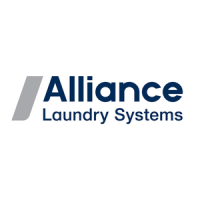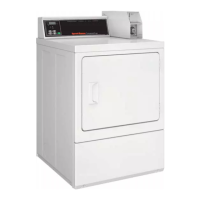



Do you have a question about the Alliance Laundry Systems ST075N and is the answer not in the manual?
Essential safety precautions for operating the tumble dryer.
Defines the meaning of DANGER, WARNING, CAUTION, IMPORTANT, and NOTE.
Lists applicable models and directs users to the serial plate.
Explains where to find the machine's serial plate for identification.
Explains the meaning of the 6th digit in model numbers related to heating.
Details control digits and actuation digits for vending options.
Provides instructions on finding the machine's serial plate.
Describes the advanced, programmable computer control for machine features.
Explains communication with PCs and networks for management.
Details how to access collected audit information via display or network.
Covers Break-In Alarm, Cycle Time, and Cycle Completion Timer.
Includes Passcode Security, Language Selection, and Lucky Cycle.
Details Reversing Modifier and Anti-Wrinkle Modifier.
Describes the capacitive touch display and primary navigation icons.
Explains the machine's ready state and the reserved Lockout Mode function.
Details the Drop Off Mode for attendant access without vend.
Covers Machine Error, Internal Control Failure, and Out of Order modes.
Explains Shutdown Mode and Rapid Advance Mode functions.
Describes the anti-wrinkle tumble feature after cycle completion.
Details the extended tumble feature after anti-wrinkle expires.
Visual guide to navigating through various cycle selection and option menus.
Outlines main categories like Rapid Advance, Settings, Diagnostics.
Details sub-menus within Settings, Diagnostics, Vend, and Cycle settings.
Explains how to open the service door for programming.
Describes how to unlock the access panel for standalone units.
Describes the initial screen shown after the machine powers up.
Covers selecting cycles, approach pages, and accessing help.
Explains how to select the display language from a list of 34.
Guides the user through starting a cycle from the approach page.
Details the menu shown when the door is open during cycle start/resume.
Describes the display during an active cycle, showing status and time.
Explains the display when a cycle is paused and how to resume.
Describes the end-of-cycle display and anti-wrinkle feature.
Details extended tumble and the special Lucky Cycle mode.
Explains how to access and use the main System Menu.
Details passcode entry and saving modified settings.
Covers Rapid Advance Activation and Cancel Cycle procedures.
Explains how to clear active errors and partial vend entries.
Guides on changing the price for specific drying cycles.
Instructions to enter and exit the Advanced Info Menu.
Details options for currency, payment methods, and vend prices.
Allows setting the default language for the display and menus.
Covers voltage, approach screen, error display, and coin settings.
Allows setting the default dry cycle and cycle times.
Explains how to view machine totals, vend counts, and cycle counts.
Covers viewing machine identification and alarm history.
Details how to monitor control inputs and manipulate machine outputs.
Explains how to enter and run factory diagnostic test cycles.
Guides on running specific component diagnostic tests.
Explains error logging, display, and clearing mechanisms.
Details specific errors related to air flow switch functionality.
Covers Break-In Alarm, Board ID, Communication B, and Voltage errors.
Details Cabinet Limit Cycle, Coin Drop, and other specific error types.
Addresses communication failures between control, drive, and fan boards.
Details errors related to drive, fan motor, and ICM module operations.
Covers gas and electric heat system failures and related errors.
Explains errors due to machine ID chip communication or configuration issues.
Details errors from output boards and payment system communication failures.
Covers fatal SCI communication errors and shorted output conditions.
Addresses errors related to thermistor readings and stove temperature limits.
Explains errors indicating critical system communication or integrity failures.
Provides maintenance checklists for daily, monthly, and yearly tasks.
Explains how to restore control settings to factory defaults.
| Brand | Alliance Laundry Systems |
|---|---|
| Model | ST075N |
| Category | Dryer |
| Language | English |












